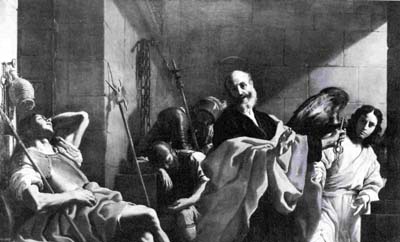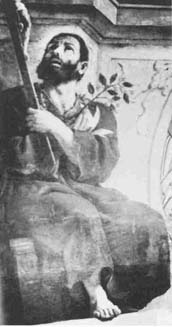
Annual Bulletin 1, 1977-1978
Home
Français
Introduction
History
Annual Index
Author &
Subject
Credits
Contact


Mattia Preti: The Feast of Absalom
by John T. Spike
Pages 1
| 2
| 3 | 4
| 5
| 6
The same
observations apply to the Christ in Preti's evidently contemporary
painting of Christ and the Woman of Samaria (Heim Gallery, London)
(fig. 4). (13) Now we arrive at our referent for the Ottawa Feast of
Absalom. With unusual exactness, Preti applied the same
observations of a brilliant white light falling on a milky
complexion to the characters of the Samaritan woman and of Absalom.
It is indicative of the degree of abstraction in Preti's style of
this period that the identical facial type shared by a young man and
a woman does not seem odd in either instance. The similarities
extend to the reddish tint of the nostrils and the copper-coloured
hair. Other coincidences between the Ottawa and London pictures are
in the treatment of drapery. The stiff fabrics buckle in their
folds. Compare Absalom's cloak with the Samaritana's, or
Absalom's sleeves and Christ's mantle. These last two are the
same shade of deep blue with a subtle resonance of dark green where
the underpainting is allowed to show through in the shadows.
The Feast of Absalom is easily related to the Samaritana, but is not
so close to other works apparently coeval to the Sambughè
paintings, among them a Raising of Lazarus, now in Genoa (Palazzo
Spinola). These pictures are populated by intense, emaciated types
comparable to the Christ of the Heim Samaritana, but which lack the
solidity of Absalom and his weighty clothes. It stands to reason,
therefore, that the Ottawa canvas falls on the chronological
limits of this group. Naturally, one cannot pretend to take the
paintings of a prolific and experimental artist such as Preti and
order them in ranks like playing cards.
But by invoking other evidence it becomes possible to suggest
whether this Feast of Absalom precedes or follows most of the group
we have associated with the fifth section of the vault of St John's.
A comparison that demonstrates the precedence of the Ottawa Feast of
Absalom also proves our assumption that Preti painted the vault
progressing towards the altar. Two paintings I believe contemporary
to the sixth section of the vault (thus representing the style into
which our Sambughè group evolved) are the Madonna with Ss
Nicholas, Peter and Raphael (the altarpiece dedicated to the name
saints of the Cotoner brothers. [The Tal-Mirakli Church, Lija,
Maital) and The Liberation of St Peter (Akademie der Bildenden Künste,
Vienna) (fig. 5). Reconstruction of the Tal-Mirakli Church was begun
in 1664, under the auspices of Grand Master Nicholas Cotoner. (14)
These paintings evince the same extreme saturation of colour and
an insubstantiality of form not found in the Feast of Absalom. The
abstraction for decorative purposes has been extended to the
drapery folds, which have been transformed into blocky shapes,
unconvincing as fabric creases, but marvelous as fields of colour.
This peculiar pattern of folds is found in some of the saints
flanking the windows in the sixth section of the vault.
We can derive an idea of Preti's very early style in Malta by the
relation of the oil on canvas Christ Risen in Glory with Saints (Museo
del Prado, Madrid) (fig. 6) to two of the paintings in the first
section of the vault of St John's. As we noted above, Preti executed
this section before 17 June 1663, but it was certainly his first
task when commencing the vault, probably in mid-1662. (15)
Portrayals
of The Blessed Pietro G. Mecatti (fig: 7) and St Toscana flank
windows on opposite sides of the nave. Both of these figure types
occur in the Prado painting, as if the same models had been used,
although the types are most likely imaginary. Equally comparable is
the handling of the heavy folds of the coarse Franciscan habits.
Preti's descriptions at this time of physiognomies and fabrics are
far more differentiated and less abstracted than in the Ottawa Feast
of Absalom. The volumes of the figures in the Prado picture are
stressed and their locations are clearly defined within a vast sweep
of space. Their arrangement has not been adjusted for optimum
decorative impact. An intervening stage in this development is represented
by the Pilate Washing His Hands of mid-1663, which was
recently acquired by the Metropolitan Museum of Art, New York.
The Feast of Absalom represents, then, a renewed investigation by
Preti of the Late Baroque tendencies he had developed in 1658-1661,
but put aside when he began work at St John's, Vailetta. Valerio
Mariani observed that Preti's apse painting is disappointingly
conventional in its disposition of figures. Preti may have felt constrained
at first by old-fashioned preferences on the part of his
Knight patrons, or by the awesome grandiosity of the commission he
had undertaken.
The other paintings that we believe are near in time to the Ottawa
picture reveal the same fresh consideration of decorative colourism
and idealized features. Most of these, for instance the Sambughè
canvasses, were painted for export. The alterpiece at Lija (c. 1666)
proves, however, that the artist did not have one style for Italy and another,
presumably more conservative, for Malta.
The presence of this Feast of Absalom and so many other paintings by
Preti in Naples ensured that his achievements were not forgotten. (16)
Borrowings from Preti can be found in the paintings of every
Neapolitan who succeeded him, although for the remainder of the
seventeenth-century in Naples, Luca Giordano's star rose to unchallenged
supremacy. The deepest impression of Preti's art was not
felt until the next century, when the fame of even Giordano's school
was eclipsed by the ascendency of Francesco Solimena ( 1657 -1747)
and his distinguished pupils.
Although greatly influenced by Luca Giordano, Solimena had not
studied that master solely. Instead, he supplemented his education
with observations of Mattia Preti's draftsmanship and naturalism. De
Dominici remarked that Solimena could be considered a pupil of
Preti's and attributed to Solimena the maxim: "Whoever follows
the Calabrese will never lose the way to perfection." (17) By
augmenting his Neapolitan legacy with works dispatched from Malta,
Mattia Preti had founded a "school" in absentia. (18)
Next Page | Notes
1 to 15
1
| 2
| 3 | 4
| 5
| 6
Annual Index | Author & Subject | Credits | Contact
This digital collection
was produced under contract to Canada's Digital Collections program,
Industry Canada.
"Digital
Collections Program, Copyright
© National Gallery of
Canada 2001"